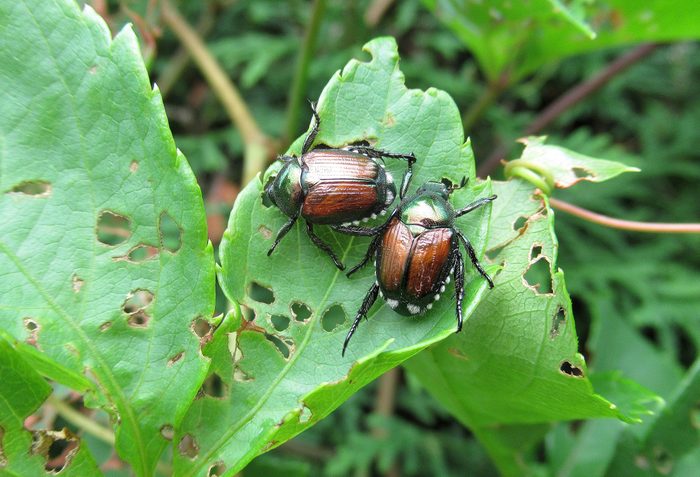Homeowner’s Guide To Japanese Beetles

An insidious muncher of more than 300 species of plants, Japanese beetles multiply quickly, making them one of the most invasive pests around.
Our editors and experts handpick every product we feature. We may earn a commission from your purchases.
If you’ve ever had your yard or garden ravaged by Japanese beetles, you know just how much destruction they leave behind. “Japanese beetles are one of the most invasive species that can cause damage to plants and turf,” says John Bell, a board-certified entomologist with Ehrlich Pest Control.
This guide to Japanese beetles will help you avoid the impact these pests can have on your yard and garden.
On This Page
What Are Japanese Beetles?
A type of scarab beetle, the Japanese beetle (Popillia japonica) has become a serious plant pest and a threat to American agriculture, according to the U.S. Department of Agriculture (USDA).
How to Identify A Japanese Beetle
“You can spot Japanese beetles with a naked eye,” says Bell. “The beetles are usually brownish across the back with a black-colored head and legs. There are white spots around the edges of their bodies, and their bodies are shiny and iridescent, usually copper in color with shades of green.”
Pro tip: Look for six white tufts of hair along the edges of the body underneath the wings. That confirms you’re dealing with Japanese beetles.
Where Do Japanese Beetles Come From?
Native to Japan — hence the name — they were first spotted in the U.S. in the early 1900s. These beetles quickly established themselves in the mid-Atlantic region, where the climate and large areas of pastureland and turf grass provided an ideal environment for them to survive and thrive.
Because Japanese beetles have no natural enemies, they’re essentially left to eviscerate large swaths of lawns, nurseries and golf courses. They prefer warm, moist environments like the Eastern and Southeastern U.S., but any soil suits them. For the last 30 years, they’ve spread to Southern and Western states as well.
Do Japanese Beetles Bite?
No. Although they have mandibles (teeth), their jaws are not strong enough to break the skin. Of all the problems Japanese beetles pose, biting humans is not one of them.
Japanese Beetle Life Cycle
“Japanese beetles do two things: reproduce and eat vegetation,” says Bell. A typical life cycle goes like this:
Adult mating/Egg laying
Adult Japanese beetles emerge from the ground in mid-summer and immediately mate. Females lay 40 to 60 eggs in the topsoil in clusters.
Larva
“In about 14 days, Japanese beetle eggs hatch and [grubs] burrow into the soil where they start feeding on the roots of plants and other vegetation nearby,” Bell says. “So right from the start, these beetles are destroying plants.” The grubs overwinter, feeding underground for about 10 months.
Pupa
In early spring, grubs turn into pupae. After several weeks, they rise from the ground as mature adults and the cycle begins again.
How Japanese Beetles Wreck Yards and Gardens
For about six weeks in the summer, swarms of Japanese beetles search for the perfect place to settle and dine. Primed to feast on a delicious smorgasbord of plants, flowers, foliage and fruit, it’s no wonder a Japanese beetle sighting can strike fear and dread in the hearts of farmers and backyard gardeners.
Signs of a Japanese beetle invasion:
- Brown patches on turf that feels spongy or lift up like carpet.
- Skeletonized, lacy foliage.
- Vegetation that’s thinned, yellowed or wilted.
- The increased presence of grub-eating animals (skunks, raccoons, moles) and birds.
- Dead plants.
- An actual beetle sighting (see above).
How To Get Rid of Japanese Beetles
Although there are no quick fixes to rid yourself of established Japanese beetles, scientists with the USDA’s Agricultural Research Service and Animal and Plant Health Inspection Service (APHIS) have developed an integrated pest management (IPM) program for homeowners based on field experience. The program combines chemical, biological and cultural strategies. Here’s a brief rundown:
Chemical controls
For homeowners who decide to use pesticides, correct timing and application are crucial for success. Every state has a chemical handbook, so check with the responsible agency in your area. Here’s a short list of chemicals that proved effective against Japanese beetles.
For adults:
- Bifenthrin;
- Carbaryl;
- Cyfluthrin;
- Deltamethrin;
- Permethrin.
For grubs:
- Imidacloprid;
- Halofenzide Trichlorfon Chlorantraniliprole (for professional applicators only).
Note: Even when used properly, insecticides can pose serious hazards to people and wildlife.
Biological controls
Some biological methods have controlled Japanese beetle populations. Although they can take longer to get results, they have a more lasting effect impact on the environment and don’t adversely affect non-target or potentially beneficial organisms. Two such methods are:
- Parasites: Tiphia vernalis, which combats grubs, and Istocheta aldrichi, which works against adults, are USDA-approved. Plant food sources on your property that will attract these parasites.
- Nematodes: These insect-eating parasitic roundworms actively seek out and kill grubs in the soil.
How To Prevent Japanese Beetle Infestations
Often referred to as habitat manipulation, you can make your yard less inviting to Japanese beetles. Here are ways to keep these pests at bay:
- Don’t plant their favorite foods in your yard.
- Place traps or bags with pheromones to entice Japanese beetles. Bell advises placing traps far away from ornamental plants to avoid attracting the beetles to the very things susceptible to damage.
- Maintain healthy trees. Diseased or poorly nourished trees and shrubs are more susceptible to attack.
- Pick fruit as soon as it’s ready. Japanese beetles love the odor of ripe fruit.



